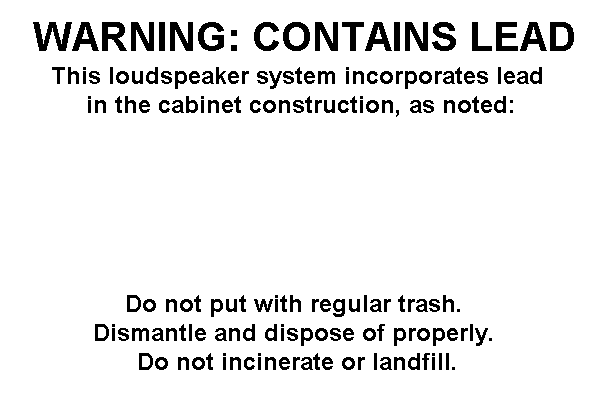The long-awaited HUMAN 81 DK is now available.
Best viewed in "landscape" mode.
Lead: Don't use it in speakers
I no longer recommend using lead in any project.
The health hazard far outweighs its usefulness.
I highly recommend simply using very thick cabinet wall material, like 1" MDF, and lots of braces, rather than adding this toxic material. The rest of this page remains purely for historic interest.
The danger is not so much in the handling and use but in the "end of product life" issues, when correct handling is not assured.
In a number of places I recommend (and show myself using) lead flashing as a damping and weight increasing material for speaker cabinets.
I realized that it would be remiss of me if I did not include a full and clear set of warnings and instructions for dealing with this toxic material.
As most people know, the basic issue here is that lead is a persistent poison that we must take all measures possible to avoid ingesting in any way. This means, for our purposes, care in three areas. The first is storage, handling, and disposal of excess while working with it. The second is how to incorporate it safely in a speaker project. This third is the eventual processing of the speaker when its useful lifetime is over.
(All quotations that follow are taken from the Material Safety Data Sheet (MSDS) I obtained through the lumber yard I buy my lead from.)
Storage:
- "This product [lead] is intended for industrial use only and should be isolated from children and their environment"
Handling:
- "Gloves should be worn when handling the product [lead]"
- "Avoid skin contact"
- "Wash hands, face, neck and arms thoroughly before eating or smoking"
(I recommend washing immediately after handling)
Disposal:
- "Dispose of toxic substances and hazardous wastes in accordance with local, state and federal regulations"
Safe use:
Lead flashing (or shot) should be encapsulated in the final product. By this I mean that none is available or exposed to the environment outside the speaker. In my EPI 1000 rebuild project, I laid the lead on the outside of the cabinet, protected only by a covering of speaker carpet. This is not recommended for any use where children might have access to the speakers, or where pets might scratch or urinate on them.
The typical use, as shown in this refurbishing project and this one, is to glue and staple flashing to the inside of the cabinet. Once the speaker is complete, this is safe. If an appropriate amount of flashing is purchased, there will also not be any scrap to dispose of.
While working on your project, take the same care as in storage, not to allow access to children or animals. I keep a dedicated pair of gloves which I always wear when handling lead. The rolling pin I used to smooth it out on the EPI 1000 project has cool things like "never use for food" and "poison" written on it in magic marker, and is also stored with my spare lead and special gloves. (You should not be keeping this stuff around unless you are going to refurbish endless pairs of speakers)
Another application, which I have done but not mentioned elsewhere, is to use lead shot (such as used by ammunition reloaders), mixing it in with some setting agent such as LevElastic in the bottom of the speaker or filling a special compartment in the bottom of the cabinet with it. The former may be appropriate and useful, the latter is probably not wise - use sand instead.
In a typical complete Do It Yourself project, I would highly recommend simply using very thick cabinet wall material, like 1" inch MDF, and lots of braces, rather than adding this material. The lead lining, however, remains a great way to add weight and damping to a vintage cabinet that is being refurbished.
End of use:
It is important not only to handle and install lead carefully, but to ensure that years or decades from now, anyone disposing of the speaker system itself will know that it contains lead and must be handled appropriately.
I suggest a permanently affixed label on the rear of each speaker that says something like:

In the space in the middle, describe where the lead is located so it can be easily separated for disposal. (Feel free to download the image itself and print it to make your label.)
Final note and disclaimer:
If you have any doubts about the use of lead in a project, or your ability to handle it safely, please do not use it. It is completely up to you to research and understand the use of this material responsibly.
* * *
Top - Contact
New Speakers -
EPI and Epicure - Genesis Physics
© Copyright - All Rights Reserved
![]()
7 Kelsey Road, Lee, New Hampshire 03861
Prices can change and specifications will improve without notice
